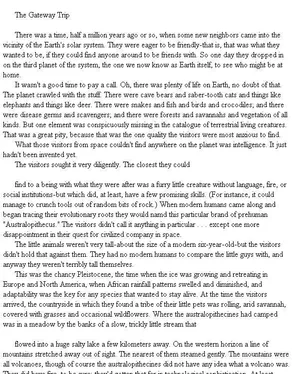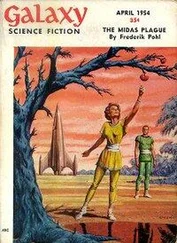Pohl, Frederik - The Gateway Trip
Здесь есть возможность читать онлайн «Pohl, Frederik - The Gateway Trip» весь текст электронной книги совершенно бесплатно (целиком полную версию без сокращений). В некоторых случаях можно слушать аудио, скачать через торрент в формате fb2 и присутствует краткое содержание. Жанр: Старинная литература, на английском языке. Описание произведения, (предисловие) а так же отзывы посетителей доступны на портале библиотеки ЛибКат.
- Название:The Gateway Trip
- Автор:
- Жанр:
- Год:неизвестен
- ISBN:нет данных
- Рейтинг книги:4 / 5. Голосов: 1
-
Избранное:Добавить в избранное
- Отзывы:
-
Ваша оценка:
- 80
- 1
- 2
- 3
- 4
- 5
The Gateway Trip: краткое содержание, описание и аннотация
Предлагаем к чтению аннотацию, описание, краткое содержание или предисловие (зависит от того, что написал сам автор книги «The Gateway Trip»). Если вы не нашли необходимую информацию о книге — напишите в комментариях, мы постараемся отыскать её.
The Gateway Trip — читать онлайн бесплатно полную книгу (весь текст) целиком
Ниже представлен текст книги, разбитый по страницам. Система сохранения места последней прочитанной страницы, позволяет с удобством читать онлайн бесплатно книгу «The Gateway Trip», без необходимости каждый раз заново искать на чём Вы остановились. Поставьте закладку, и сможете в любой момент перейти на страницу, на которой закончили чтение.
Интервал:
Закладка:
What everyone agreed on, at last, was that the Heechee were gone.
And that was just where everyone was very wrong.
It was not true that the Heechee had died. Certainly not as a race, and, funnily enough, in an astonishing number of cases they hadn't even died as individuals.
The Heechees were very much alive and well. The reason they were not found was simply that they didn't want to be. For good and sufficient reasons of their own, they had decided to conceal themselves from any unwelcome attention for a few hundred thousand years.
The place where the Heechee hid was in-the core of the galaxy, within an immense black hole-a black hole so enormous that it contained thousands of stars and planets and satellites and asteroids, all orbiting together in a space so small that their combined mass had pulled space in around them. The Heechee were all there-several billion of them, living on some 350 roofed-over planets inside their Core.
To create their immense hidey-hole, the Heechee had tugged together 9,733 individual stars, together with their appurtenant planets and other orbiting objects. That gave them, among other things,
some really spectacular nighttime skies. From the surface of the Earth, human beings can see at most maybe four thousand stars with the naked eye, ranging from fiery blue-white Sirius all the way down to the sixth-magnitude ones that lie on the squinting border of visibility. The Heechee had more than twice that many to look at, and they were easier to see because they were a whole hell of a lot closer-blue ones far brighter than that familiar Sirius, ruby ones almost as bright as Earth's Moon, asterisms of a hundred stars in a bunch and all wondrously bright.
Of course, that same stellar population density kept the Heechee from having much in the way of nights. Except when the clouds were thick they just weren't used to much darkness. On their planets inside the Core there was seldom a time when the collective stellar effulgence didn't give them light enough at least to read by.
With all those stars, they had plenty of planets to live on. The Heechee only occupied a fraction of the available planets, but they had made the ones they chose to live on very homey. Naturally, a
very high proportion of those planets were temperately warm, benign in atmosphere, and right-sized for the kind of surface gravity the Heechee enjoyed (not all that different from Earth's, as it happened). That wasn't any accident. They had naturally chosen the cream of the crop to shift into their Core colony so they could inhabit them. There they built their cities and their factories, and laid out their farms and cultivated their oceanic fish ponds-none of those things looked exactly like the human equivalents, but they all worked just as well. Generally they worked a lot better. All of this building and making and growing was so thriftily done that the Heechee avoided pollution and everything unsightly. They were as snug as bugs in a rug.
It wasn't quite perfect. But then, nothing is. Jamaica has hurricanes, Southern California has its Santa Ana winds, even Tahiti has its rainy seasons. The most nearly ideal of climates generally has a few unpleasant kinds of weather. The Heechee had their own weather problems in their Core hideaway. For them, it wasn't rain or wind, it was the built-in nastiness of any black hole. Black holes pull whatever happens to be nearby into themselves. They do o with great force, producing high velocities and a lot of turmoil. This expresses itself in radiation. It was only from this production of radiation that black holes were first detected by human astronomers, and it is deadly, ionizing stuff.
So everywhere in the Core there was a permanent shower of damaging charged particles, which meant that the Heechee usually had to roof over their worlds. The crystal spheres that surrounded every planet kept out the more dangerous radiation from all those nasty sources. Meanwhile, the Schwarzschild radius of their immense black hole kept out something they feared even more.
That was why they had retreated the way they had. Now they were waiting.
Of course, the Heechee needed a way in and out of their great black hole, and, of course, they had one. Human beings had the same thing, too, in some of those abandoned Heechee ships they had found, but it didn't do them much good because they didn't know they had it.
That was a general problem with Heechee technology. When human beings found pieces of it they also found a lot of confusion. The Heechee had not been kind enough to leave operating manuals for the humans to pore over. They hadn't even put labels on the machines-at least, not in any way that human beings could read. The best way for human beings to find out what all those gizmos and gadgets were for was what used to be called reverse engineering, which basically meant taking them apart to see how they worked.
The trouble with that was that when engineers tried it, the damned things often blew up. So they tended to treat the machinery with caution, and if they didn't know what it was for, and couldn't figure out any way of trying it out, they tended to leave it alone. Take that crystally, twisty rod sort of thing that was part of the furnishings of some, but not all, Heechee ships. They knew it had a purpose. They didn't know what it was.
If anyone on Earth had known where the Heechee lived, they might have guessed that one a lot sooner... but no one did, and so the human race had in its hands an instrument for penetrating black holes long before anyone knew what it could do.
It was a while before any human being knew exactly what a Heechee looked like, for that matter. Still, they are easy enough to describe.
A male Heechee is about five feet tall, on average. His head is the Aryan ideal Nordic squared-off block, only a little more so, though his skin color isn't Nordic at all. If he is male it is probably a sort of oak-bark brown; if female, she is generally somewhat paler. The Heechee skin looks as though it were carved out of shiny plas
tic. A dense, fine growth of hair covers his scalp, or would if he didn't keep it cropped very short. He smells ammoniacal to human beings-the Heechee themselves don't notice it. There is no iris to his eyes. There isn't really even a pupil, just a vaguely X-shaped dark blotch in the middle of a pinkish eyeball. His tongue is forked. And his general build
Well, what you would think of a Heechee's bodily build would depend on whether you were looking at him from the front or from the side.
If a human being were squeezed flat, he would come out of it looking like a Heechee. Viewed from the front, your Heechee would look formidable; from the side (except for a rather potbellied, globular abdomen), quite frail. What he would most look like (though not so exaggerated) would be the cardboard-cutout skeletons children decorate their schoolrooms with at Halloween. This was especially true around the hip and leg joints, because the Heechee pelvis was structurally rather different from the human. The legs attached directly to the ends of the pelvis, like a crocodile's, so there was a considerable space between the legs as a Heechee stood e r~ct.
The Heechee didn't waste that space. It was the most convenient place for a Heechee to carry anything, so the sorts of loads human beings would be likely to lug in their arms or on their shoulders the Heechee carried slung between their legs. In fact, all civilized Heechee carried a large, tapering pouch there. In it they kept two main items-the microwave generators they needed for their comfort, and the storage facilities for the "ancient ancestors" whose minds they carried around with them, as a human being might carry a pocket calculator-as well as their equivalents of fountain pens and credit cards and photos of their near and dear. And when the Heechee sat down, what they sat on was the pouch.
Читать дальшеИнтервал:
Закладка:
Похожие книги на «The Gateway Trip»
Представляем Вашему вниманию похожие книги на «The Gateway Trip» списком для выбора. Мы отобрали схожую по названию и смыслу литературу в надежде предоставить читателям больше вариантов отыскать новые, интересные, ещё непрочитанные произведения.
Обсуждение, отзывы о книге «The Gateway Trip» и просто собственные мнения читателей. Оставьте ваши комментарии, напишите, что Вы думаете о произведении, его смысле или главных героях. Укажите что конкретно понравилось, а что нет, и почему Вы так считаете.












